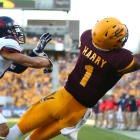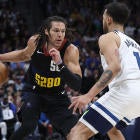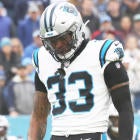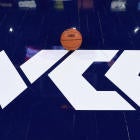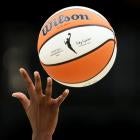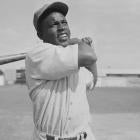The top of each NFL Draft is typically headlined by a handful of underclassmen, so it's vital to know which talented sophomores or juniors could see their stocks rise enough for it to be a logical decision to forgo their final season at the collegiate ranks.
Six of the top 10 picks in the 2018 draft were underclassmen. In 2017, that number was seven.
While all of these prospects won't rise to the first 10 selections in the 2019 draft, here are some important underclassmen to monitor during the 2018 college football season from a draft angle.
(And you won't see established 2019 draft headliners -- who are underclassmen -- like Ed Oliver, Nick Bosa, or Rashan Gary here. I dug a little deeper.)
Quarterback
The former No. 4 overall recruit and top quarterback in the nation according to 247Sports, Patterson joined the Ole Miss program as a five-star from the famed IMG Academy in Florida and completed 60.7 percent of his passes at 8.0 yards per attempt with 23 touchdowns and 12 interceptions over 10 games before transferring to Michigan.
At 6-feet-2 and a little over 200 pounds, Patterson isn't the biggest signal-caller in the Big Ten, but there are some Manzielian qualities to his game on the collegiate level. He's a crafty improviser and is difficult to bring to the turf behind the line. Despite his lack of traditional NFL quarterback size, he possesses a strong arm and has good but not great accuracy. Now 21 years old, Patterson will receive the sage quarterback tutelage of Jim Harbaugh, who's fallen on some hard times in Ann Arbor ironically due to average-to-abysmal quarterback play. Harbaugh needs Patterson and Patterson needs Harbaugh. After one, high-profile season on a loaded Michigan club that gets to, say, the College Football Playoff, it wouldn't be shocking if Patterson left for the NFL.
Running back
Defenses facing Oklahoma will finally be put at relative ease now that Baker Mayfield is in the NFL. Unfortunately for those units, the Sooners will again boast one of the most physically overpowering blocking groups in college football and can lean on Anderson who pieced together a remarkable yet somewhat unheralded 2017 with 1,440 yards from scrimmage and 18 touchdowns.
At around 6-2 and 220 pounds with explosive, one-cut ability, deceptive long speed, and reliable hands, Anderson has the skill set of a modern-day NFL power back. He'll split time with the speedy Trey Sermon, but the junior should squarely move onto the 2019 draft radar with what's likely to be another monster season at Oklahoma.
Wide receiver
N'Keal Harry, Arizona State
Harry is one of the most highly touted recruits to ever play for Arizona State. Per 247Sports, he was the No. 7 overall wide receiver in the country in 2016 when he choose the in-state Sun Devils over the likes of Texas A&M, Texas, Oregon, Louisville, UCLA, USC, Washington and Wisconsin. And Harry has been a star in Tempe for two years now. When watching him last season then re-watching him recently, I kept thinking A.J. Green. Harry's long, fluid, effortlessly athletic and has the tenacity required to repeatedly make difficult catches in jump ball situations or tight coverage.
He accounted for 34.3 percent of Arizona State's receiving yards in 2017 while playing the majority of the season as a 19 year old. As outlined by the Phenom Index -- which was created by RotoViz's Jon Moore -- relatively young pass-catchers with high yardage market shares (typically above 30 percent) in college usually go on to have very successful NFL careers. Harry should be a hassle to cover as a junior, and it shouldn't surprise anyone if he's picked in the first round of the 2019 draft.
Tight end
At Stanford, they run the football and provide the NFL with well-trained, ready-to-produce tight ends. Latest in the long line of those tight ends is Smith, a 6-5, 250-pound soon-to-be junior who averaged 18 yards per catch and scored five touchdowns on 23 receptions in 2017. Many of his seam-stretching grabs were of the highlight-reel variety, and he put on an show in the Pac-12 title game against USC with four snags for 80 yards and two touchdowns, both of which were made with arms extended over his head.
With only one year of production on his résumé, there's a decent chance Smith returns for his senior season and ultimately becomes a 2020 prospect. However, he's undoubtedly worth the watch in 2018 because outside of his pass-catching ability, Smith was a reliable run-blocker on the edge for David Shaw's club. And he if demonstrates more well-rounded play this year with increased receiving numbers, he could be an early entrant to the 2019 draft and get picked in one of the first few rounds.
Offensive line
Jake Hanson, Oregon
A season ago, Oregon averaged 5.2 yards per carry as a team, which, when the handful of triple option clubs are discounted, means the Ducks finished in the top 20 in college football in that statistic. Beyond 2018 fifth-rounder Tyrell Crosby -- who should've been picked earlier than that -- Hanson was a major part of Oregon's running efficiency. At center, the sophomore displayed plus athleticism on combo blocks to the second level and was adequately strong at the point of attack when dealing with bull rushes. At times he can be a little overzealous when approaching his blocks, which leads to him getting off-balance with his shoulders in front of his feet.
In general though, Hanson played well beyond his years in 2017. A host of eyes will be on Hanson this season as he snaps the football to marquee quarterback prospect Justin Herbert on what's likely to be the best Oregon club we've seen in a few years. With more under-control play and added strength, Hanson could find himself among the top of the interior offensive line prospects in next year's draft.
Defensive line
Burns was a four-star recruit and the No. 46 overall player in the high school class of 2016 according to 247 Sports, and he's thrived since his first season for the Seminoles. The menacing defensive end had three tackles for loss and two sacks in his first collegiate game in September of 2016. In total, Burns has 13 quarterback takedowns and 23 tackles behind the line in his two seasons in Tallahassee and has grown into his 6-5 frame. He could add even more weight -- he's now listed at 231 -- which would help him convert impressive speed off the edge into power at the point of attack.
Now a true junior, Burns is Florida State's clear-cut best pass-rusher. His combination of explosiveness and length will give many ACC offensive tackles fits throughout the season. If he eclipses double-digit tackles for loss (again) and nears 10 sacks while displaying some hand usage to go along with his springy athleticism, he'll have the makeup to be an early-round selection if he decides to enter the 2019 draft.
Linebacker
Box-score scouting is typically viewed in a negative light in the scouting community but I've learned that with linebackers, high-production players are typically excellent NFL prospects. (see: Luke Kuechly at Boston College, Bobby Wagner at Utah State and Lavonte David at Nebraska). In short, it's usually really difficult to "scheme" tackles for a linebacker.
In Giles-Harris' first season at Duke in 2016, he amassed 107 tackles, 9.5 tackles for loss, four sacks, two pass breakups and a pick. Last season, he filled the stat sheet with 125 tackles, 16 tackles for loss, 3.5 sacks, four pass breakups, and another interception. For being a relatively young linebacker in 2017, Giles-Harris showcased refined ability to shed blocks, an imperative skill at his position, to go along with above-average speed and change-of-direction ability. If his statistics continue to improve on an upstart Duke club in 2018, he'll likely be among the top off-ball linebacker prospects in the 2019 class.
Defensive back
Taylor Rapp, Washington
Tipping the scales at 6-0 and around 200 pounds, Rapp has already shown wide-ranging versatility in his two seasons at Washington. As a freshman in 2016, he displayed impressive range from the free safety position, and legitimate ball hawks with the ability to make plays across the entire width of the field are very hard to come by. That year he reeled in four picks, and while a few were of the tipped variety, the pick six he had against Colorado in the Pac-12 title game was gorgeous. He covered a ton of ground as he ran from the far hash to get underneath a deep cross before taking it to the house. Last season, Rapp was more impactful against the run and as a blitzer, as his solo tackles jumped from 29 to 42, and he had 3.5 tackles for loss to go along with two sacks. He's not one to miss many tackles despite playing at full throttle the entire game. On what should be one of the better defenses in the Pac-12 once again, Rapp is likely to build on two strong seasons for the Huskies and become one of the premier safety prospects in the 2019 draft class if he decides to leave school early.












